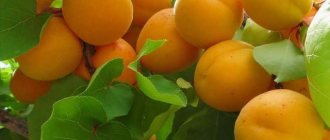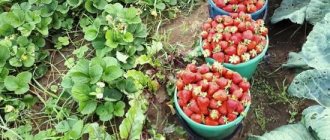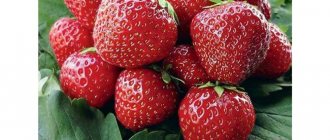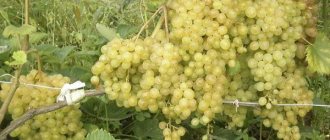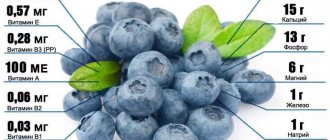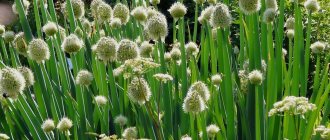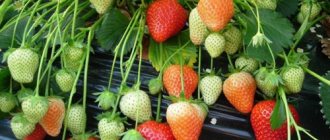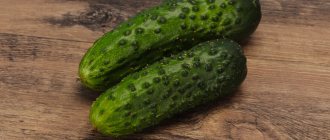Dukes occupy an intermediate position between the parent species, cherries and sweet cherries, but in general they are still closer to cherries. The leaves are similar in size to cherry leaves, but denser and with a characteristic cherry sheen. The fruits are usually much larger than cherries, sweeter, and the sourness is light and pleasant. The aroma for which we love cherries is also preserved in Dukes.
- From the history of the appearance of Dukes
- Conditions for growing dukes
- Promising varieties and pollinators of Spartanka dukes
- Ivanovna
- Miracle cherry (cherry Griot Ostgeimsky x cherry Valery Chkalov)
- Nochka (cherry Nord Star x cherry Valery Chkalov)
- Nurse
- Shpanka Donetsk
The most valuable property of hybrids is their increased resistance to common cherry diseases - coccomycosis and moniliosis.
Duke features
Hybrids of cherries and sweet cherries differ in many ways from their “parents”:
- Unlike parental pairs, dukes are self-sterile. “Loneliness” is contraindicated for them. In order for the hybrids to bear fruit, zoned varieties of cherries and sweet cherries, the so-called pollinators, are planted nearby.
- Dukes themselves are ineffective as pollinators.
- In the middle zone and in the Central Black Earth region, self-fertile cherries - Lyubskaya, Bulatnikovskaya, Molodezhnaya - are usually used to pollinate dukes.
- The best pollinator of dukes is the cherry. Recommended pollinators for cherry trees are Donchanka, Priusadnaya, and Annushka cherries. And the Iput cherry is considered an ideal variety for pollination.
You can read about the listed varieties of cherries in the following article.
- When purchasing duka seedlings, you also acquire a pollinator. A high-quality pollinator is able to pollinate more than a third of the flowers - this is enough for the tree to be covered with fruits.
- Dukes, compared to cherries, are more winter-hardy. On the contrary, cherries are inferior in winter hardiness. Because of this, in the northern regions they grow in the form of bushes - gardeners cover them for the winter, saving them from extremely low temperatures.
- Dukes are not fed throughout their lives. Due to an excess of nutrients, the tree begins to develop intensively, which, spending energy on growth, does not have time to really get stronger and prepare for winter. This leads to the absence of fruits or the death of the plant.
The second name for cherry is duk. In the 17th century, a hybrid of cherries and sweet cherries was developed in England; it was named “May-Duke,” which literally means “Duke of May.”
Frost-resistant varieties of dukes
Dukes are a hybrid of cherry and cherry (they are called cherry-cherries or cherry trees). An interesting garden crop that can delight not only residents of the southern CIS countries and regions of the Russian Federation with juicy drupes of unusual taste, but also regions where winter weather is frosty beyond -25..-35 °C.
Dukes need a pollinator, so they need to be planted next to several varieties in the garden. Individual clumps of different varieties of dukes look great when forming a garden landscape.
Hybrid of cherries and sweet cherries - Duke, variety "Kormilitsa"
Duke varieties for central Russia
The Duke variety Krasa Severa was bred by I.V. Michurin in the 19th century. Constant work with the resulting hybrid made it possible to obtain a frost-resistant variety that is tolerant of spring temperature changes and can easily withstand frosts down to -30°C. Fruiting is early - in the first half of July. The fruits are light pink in color. The pulp is yellowish, juicy, the juice is uncolored. The taste of the fruit is sweet with a slightly noticeable sourness, refreshing. The pit is easily separated from the pulp. Frost resistance is so high that the variety grows normally and produces yields in Siberian conditions (Tomsk).
The Duke Miracle Cherry variety is most famous among gardeners for its abundant fruiting. The branches of the crop are literally strewn with bunches and garlands of large fruits. The variety is self-sterile. The best pollinators are the cherry varieties Yaroslavna, Sesstrenka, Donchanka, Annushka, and other varieties of duki. The fruits ripen in the second half of June. Fruits weighing up to 10 g, round, dark red with the same pulp. The pulp is sweet, more tender than that of cherries with a pleasant cherry flavor and aroma. The variety is grown as trees in the south, and in central Russia - in the form of a bush with little shelter from the drying winter-spring winds.
In the conditions of the Moscow region, you can successfully grow varieties of duka: Zhukovskaya, Pamyati Vavilova, Kormilitsa, Krepkaya. Duke berries have a cherry flavor, enriched with a cherry aroma with a pleasant, refreshing aftertaste. The fruits are high quality.
Hybrid of cherry and sweet cherry
Duke varieties for the Northern regions
Breeders have obtained hybrid varieties of dukes, the winter hardiness of which allows them to be grown in Siberian conditions, more practical - in a bush form.
The Duke variety Alice is a mid-late variety. The fruits are dark red with delicate colored pulp. The taste of the fruit is sweet and sour, the juice is red. Due to the tender juicy pulp, transportability is low. Distinctive feature: the winter hardiness of the variety is generally high, but flower buds can freeze in severe, long-term frosts.
The Duke Dorodnaya variety belongs to varieties with medium-late fruit ripening. The trees are self-fertile. Pollinators - cherries, sweet cherries, and other varieties of dukes. The fruits are large, round, dark red with colored pulp and juice. The taste is sweet with noticeable sourness. Forms a high crown in the form of a tree. Winter hardiness is high.
Dukes in the northern regions can be grown in private gardens and dachas using the following varieties: Pivonya, Nochka, Excellent Venyaminova.
The Dyukov varieties Ivanovna and Spartanka are distinguished by their very high winter hardiness.
See the continuation of the list of frost-resistant varieties of popular fruit crops for cold regions on the next page.
Description and characteristics
The cherry tree is small, the crown is compact. The branches, arranged symmetrically, are covered with elongated glossy leaves. The inflorescences are white and the fruits are red-cherry.
Duke, being an intermediate crop, combines the characteristics of two plants at once:
- Fruit. In appearance and taste of the fruit, duki are closer to cherries, but in size and sugar content they are similar to cherries.
- Leaves. Large, like cherries. Density, color and shine - like cherry.
Cherry characteristics:
- The average weight of berries is 8-10 g.
- The taste is sweet, with slight sourness.
- The first fruits appear in the 3rd year after planting.
- The average yield is 10-15 kg per tree per season.
The most delicious varieties of cherries for the Moscow region
When choosing a cherry variety, you want the berries to be not only healthy, but also tasty. That is why it has long been customary to plant Vladimirskaya. Its unique lukewarm taste is recognized by professionals as excellent, and gardeners treat it with love. Selection work did not stand still and varieties appeared that were given the highest scores by professional tasters.
The undisputed leader among the most delicious is the Shy cherry variety. In spring, this medium-height tree will decorate the area with white flowers, collected in inflorescences of three. The variety ripens late and is not distinguished by outstanding winter hardiness and disease resistance. The main thing is that the large fruits of this variety will leave few people indifferent, if only because the almost black skin hides juicy, very tasty dark red pulp.
With a large fruit mass, the Shy berry variety contains quite a few acids, with a fairly high sugar content
Due to its partial self-fertility, Shy is rich in harvest, which can be served and used for harvesting.
The parade of delicious cherries continues with the Pamyat Enikeev variety.
Even though Pamyat Enikeev comes in second place, it is actually an early ripening variety. It is also important that its dark red large juicy berries can be tasted already in the 4th year.
Cherries of the Pamyat Enikeev variety are not only champions of taste, but also the largest among the most delicious
The self-fertile tree of this variety has average winter hardiness and resistance to coccomycosis.
The medium-sized, fast-growing bush of the Assol variety will continue. On 4-5 year old bushes of the mid-ripening Assol variety, tender juicy fruits with a pleasant sourness will appear.
Recent Entries
What kind of house to build: comparing aerated concrete, expanded clay block or silicate block Planting grapes in the fall as an alternative to spring: what are the benefits? Technology for pruning cherries in the fall: diagrams and instructions for beginners
The Assol bush is winter-hardy and self-fertile.
The Volochaevka variety is fourth in the top five. Volochaevka fruits managed to combine small size, very good taste and high vitamin C content. The coccomycosis-resistant and winter-hardy Volochaevka variety is endowed with a yield exceeding the Pamyat Enikeeva and Assol varieties.
Cherries of the Volochaevka variety can successfully please with their taste both fresh and in preparations
The last fifth place is occupied by the Shokoladnitsa variety. The last on the list, but far from the least unique cherry variety, will surprise you with its fruits. The berries of Shokoladnitsa are not large in size, but contain more sugar and acids than Shy, Memory of Enikeev, Assol and Volochayek.
Many gardeners claim that the berries of the Shokoladnitsa variety combine the taste of cherries and sweet cherries.
The winter-hardy and partially self-fertile Chocolate Tree will delight you with a large harvest every year.
The top five most delicious cherries are compiled based on data from the State Register
| Place | Variety | Berry weight | Taste | Tasting assessment | Dry matter content | Sugar content | Acid content |
| 1 | Shy | 4.5 g | Sweet and sour | 5 | 16,2% | 11,2% | 0,86% |
| 2 | Memory of Enikeev | 4.7 g. | Sweet, with pleasant acidity | 4,8 | 16,3% | 10% | 1,4% |
| 3 | Assol | 4.2 g | Sweet and sour with pleasant sourness | 4,7 | 15,5% | 10,0% | 1,3% |
| 4 | Volochaevka | 2.7 g | Sweet and sour | 4,7 | 15,6% | 10% | 1,4% |
| 5 | Chocolate girl | 3 g | Sweet and sour | 4,6 | 18,4% | 12,4% | 1,6% |
Advantages and disadvantages of a hybrid
Each of the parent trees - cherry and sweet cherry - are good in their own way, but their hybrid also has enough advantages. Cherry benefits:
- Disease resistance. They are immune to moniliosis and coccomycosis - diseases due to which many cherry orchards have no harvest for years. There are dukes that are almost not affected by the cherry fly.
- High taste characteristics. The fruits of duki have a wonderful taste - a unique cherry flavor combines favorably with cherry sweetness.
- Large fruit. The maximum fruit weight reaches 15-20 g.
- Frost resistance. The tree withstands frosts down to 24-26 °C
- Low maintenance requirements. Virtually no need for feeding. The amount of watering becomes minimal with age.
Cons of cherry:
- The buds do not withstand frost well enough and are prone to freezing.
- Poor transportability.
- Needs regular pruning as it is prone to overgrowth.
The best varieties
The different set of chromosomes of cherries and cherries greatly complicated the task set by botanists to develop varietal diversity of dukes. That is why the choice in domestic selection for a long time was very scarce. Among European offerings in the last century, the French-produced varieties “Queen Hydrangea” and “Empress Eugenie” were in demand.
Today they have been supplanted by our relatives:
mid-early
- “Saratov baby” (characterized by the high yield of a medium-sized tree and large dessert berries, which are hidden in the thick of the crown and inaccessible to birds);
- “Miracle Cherry” (distinguished by its resistance to droughts, pathogens and harsh winters, produces high yields annually);
- “Pivonya” (worthy of attention due to the taste of the crop);
average in terms of ripening
- "Hodosa" (is a hardy tree that produces large and juicy berries with a sweet and sour taste;
- “Spartanka” (a feature of this Duke variety is its increased frost resistance, so it is recommended for the northern regions);
- “Dorodnaya” (outwardly it is a tall tree with large juicy fruits);
- “Nurse” (the variety is the best in terms of fruit quality);
- “Fesanna” (the berries of this variety can easily be called the standard of cherry taste);
mid-late
- “Ivanovna” (is the leader in the varietal diversity of this group and is a low tree with large red berries);
- “Nochka” (the advantage of the breed lies in the genes for resisting the pathogens of moniliosis and cocomycosis);
- “Excellent Venyaminova” (the peculiarity of the variety is its dense, fleshy berries).
Important! When purchasing cherry tree seedlings, be careful. Sometimes they are sold without indicating the variety under the general inscription “duke” or “cherry-cherry.”
The danger of such seedlings lies in their unknown origin, since rejected specimens with poor fruit-bearing and winter-hardy characteristics of the maternal genes are often sold in this form.
Optimal growing regions
Since breeders have developed dozens of winter-hardy cherry varieties, they have been grown in almost all regions of Russia. When choosing a variety for planting, it is important to correlate its frost resistance - the lowest possible temperature withstandable - with the winter temperatures characteristic of a particular region. Depending on climatic conditions, the appearance of the plant is formed - in the form of a tree or in the form of a bush.
The first cherry trees did not feel comfortable even in the middle zone, but today’s varieties are hardy and frost-resistant, and have moved far to the north. Today, dukes grow and bear fruit in the Leningrad, Nizhny Novgorod, Novosibirsk regions, Siberia, and the Far East.
Landing
The main features of proper planting of cherry seedlings are maintaining intervals between neighboring plants and preparing the pit. All other agrotechnical measures are the same as for other fruit trees.
Selecting a location
When creating plantings of dukes, cherries and cherries, it is recommended to select a site that meets the following requirements:
- Sunlight all day long. There should be no shadow, but partial shade is allowed.
- The soil must be nutritious. Wetlands are excluded.
- Elevation is preferable; the groundwater table should not be higher than 2 m.
- Protection from drafts and winds.
- There should be cherry and/or sweet cherry trees nearby for pollination.
- The minimum distance to neighboring crops is 5 m.
Dukes are not planted in lowlands. In winter, cold masses are concentrated here, and in summer the humidity is too high. The best option for dukes is areas with sandy loam soils and indirect, diffused light.
Acidic soils are neutralized with chalk - add 1.5 kg per 1 sq. m. m. Heavy clay soils are replaced during planting with fertile soil and sand mixed in equal parts.
When preparing the soil for planting, you should maintain fertilizer standards for dukes - they do not like soils that are too nutritious.
Purchase and preparation of seedlings
Cherry seedlings are prepared for planting in the same way as any other planting material for fruit trees. The seedlings are soaked in water a day before planting, and then all damaged roots are cut off with pruning shears.
When buying duke seedlings, pay attention to:
- age and time of landing;
- variety;
- pollinators.
Seedlings aged 2-3 years are considered to have the best survival rate. Other recommendations for choosing planting material:
- the presence of a tag indicating the age of the seedling, variety, pollinator varieties and other details of agricultural technology;
- trunk – straight;
- the root system is developed, without signs of disease;
- shoots are colored evenly, without gum or damage;
- the height of the main trunk is about 60 cm, the branches are shortened by a third - such signs indicate properly prepared planting material;
- the variety must be regionalized and suitable for specific climatic conditions.
The health of the roots of seedlings is indicated by the white color of their cuts.
Duke seedlings should be purchased from nurseries or specialized farms that professionally grow fruit trees.
Landing in the ground
It is better to plant dukes in early spring, when the soil has warmed up to the desired temperature. If you plant seedlings in the fall, they may die without taking root. Autumn planting is only suitable for regions with warm climates.
Features of planting duka seedlings:
- The pit is prepared a month before planting.
- The distance between adjacent holes is 4-5 m if 2 or more cherry seedlings are planted. This is enough so that the trees, when they become adults, do not interfere with each other.
- The dimensions of the hole must be such that the root system fits freely in it.
- Drainage must be laid at the bottom of the hole to prevent stagnation of water near the root system. Make a drainage layer from stones or broken bricks.
- A manure-soil mixture is poured onto the drainage. The mixture includes a fertile layer.
- The soil obtained by digging a hole is mixed with superphosphate (300-400 g), potassium sulfate (250-300 g) and ash (2-3 cups).
- If planting is done in infertile, depleted soil, compost or humus is added to the hole - one bucket.
- The seedling is placed in a hole, its roots are straightened. Sprinkle with soil so that the root collar and the surface of the earth are at the same level. You should not bury the seedling too much - rot may develop, which will lead to the death of the young tree.
- When the seedling is planted, water is poured under the root - 2 buckets.
general information
Duke is a hybrid form of fruit plant obtained as a result of an unplanned cross-pollination of the May Duck cherry with a cherry tree. This synthesis aroused the interest of breeders, so they purposefully began breeding seedlings of this species, using seedlings of the first cherry tree.
It is worth noting that the plant got its name from the name of the cherry variety, which took part in the creation of a new type of fruit tree. But it has not taken root in European countries, so such trees are called this only in Russia.
In the first half of the 19th century, people interested in growing cherry trees chose the Empress Eugenia and Queen Hortensia varieties for this purpose. In 1888, the Soviet biologist Ivan Vladimirovich Michurin, by crossing the Winkler white cherry and the Bel cherry, obtained the first domestic variety, which was called the Beauty of the North. Until now, it is considered the most frost-resistant duke. They even tried to grow the beauty of the North in Western Siberia, but not always successfully - often the flower buds of the trees froze, which led to low yields.
Until the end of the 80s of the 20th century, the choice of dukes was small. The different set of chromosomes in cherries (32) and sweet cherries (16) complicated the work of breeders. Most of the new varieties had flaws:
- Infertility - fruits were not set or there were very few of them.
- Frost intolerance - trees suffered from frost and were unable to survive the winter.
As a result, botanists working in scientific institutions of the Voronezh region still managed to obtain a group of fertile plants that were suitable for cultivation even in the northern regions.
Cherry care
Caring for hybrids of cherries and sweet cherries does not cause difficulties even for novice gardeners. By devoting a minimum of time to this unpretentious tree, you get large harvests of delicious berries. Unlike other fruit trees, dukes do not need fertilizing, which makes care even easier.
Regularity of watering
It is recommended to water the planted young plants every week. Water abundantly, use settled water, not cold. The older the tree gets, the less frequent the watering. Watering for dukes is a must, regardless of age. An adult tree requires approximately 20-40 liters of water. During periods of prolonged drought, the displacement is increased.
Like all stone fruits, cherry trees do not like frequent and abundant irrigation. Overmoistening leads to rotting of the roots and cracking of the trunk bark and skeletal branches. Trees need more watering until they are 5 years old, and then the frequency of irrigation is reduced based on the weather.
The need for digging and mulching
To make the root system feel comfortable, two loosenings per season are enough. Loosening saturates the soil with oxygen and at the same time removes weeds. It is recommended to loosen the soil in tree trunk circles after watering. Gardeners often sow green manure in gardens to fertilize the soil; for dukes, this option is allowed, but with one condition - the tree trunk circle should only be under black fallow.
To prevent the tree roots from overheating and moisture from the soil from evaporating too quickly, the tree trunk circle is mulched. Recommended mulch is hay. Do not spread mulch on dry soil.
Top dressing
The absence of the need for feeding is an important advantage of dukes. Fertilizers are applied only when planting a seedling. In the future, the gardener is spared from fertilizing - the dukes develop better and bear fruit in soils of average nutritional value.
Pruning and crown formation
The first time cherry trees are pruned immediately after planting. From the surface of the ground to the pruning point - 0.6 m. Having trimmed the top, cut off the skeletal branches. On seedlings 2 years old, the side branches are cut by 1/3.
While there is no harvest, the young animals are growing intensively. And as soon as the first berries appear, growth activity decreases. The crowns are thinned out in a timely manner - their thickening leads to a decrease in yield. When cutting branches, take into account the angle at which they depart from the trunk - the sharper it is, the smaller the end to be cut off.
For old trees, rejuvenating pruning is carried out every 5 years - sprouts are removed from the entire crown - to the level of four-year-old trees.
Diseases and pests
Among the fungal diseases that threaten dukes, the most dangerous and common ones are shown in Table 2.
table 2
| Pests and diseases | Symptoms of the lesion | Control measures |
| Fruit rot | The fruits have characteristic putrefactive spots. It develops when the integrity of the surface of the berries is damaged - for example, after a hailstorm or due to pest damage. | Spray with fungicides 1-4 times for 7-10 days. For example, Topaz, Previkur, Skor and others. Or they use folk remedies - ash, soda, garlic infusion, etc. |
| Powdery mildew | A white coating appears on the leaves - they become deformed, change color, and then fall off. | Prevents fruit damage. Perform preventive spraying with Fitosporin-M. An iodine solution also helps - 10 ml per 10 liters of water. Spray the entire tree, repeating the procedure after 3 days. |
| leaf roller | Chewed and curled leaves. | They are treated with biological insecticides (Bitoxibacillin, Lepidotsid) or chemicals (Ditox, Karbofos, Fufanon). |
| cherry fly | Larvae develop in the fruits and eat the pulp. | Treatment with universal chemicals (Sigmaen, Fufanon and others) or folk remedies. They are repelled by herbal plants, sprayed with fragrant infusions, and caught with sticky traps. |
Preparing for winter
Modern varieties of dukes are quite frost-resistant, so they do not require insulation for the winter - mulching the tree trunk circle is enough. Hay or fallen leaves are used as mulch. Varieties that are not particularly resistant to frost, grown in regions with harsh winters, are better insulated. Seedlings that have not reached 5 years of age are insulated for the winter, regardless of the growing region.
Insulation of dukes:
- the crown is covered with thick and dense polyethylene;
- The tree trunk is covered with snow.
Many gardeners wrap the trunks of fruit trees, including dukes, with burlap. Or covered with spruce branches. This method of shelter allows you to solve two problems - to save the tree from frost and from rodents. Hares are a terrible danger to young trees, and the smell of pine needles effectively repels them.
Fruiting and pollinators of the Miracle cherry
The tree begins to bloom during the onset of stable warm weather. Most often this is mid-May. In regions with colder climatic conditions, this period may begin at the end of June.
The flowers of this cherry variety are quite massive, they form on short stems. Flowers are connected in brushes of 4-9 pieces.
Fruiting occurs on short (0.5-5 cm) fruit formations (also called bouquet branches), which are located at the top of the tree. Bouquet branches consist of fruiting and growth buds.
The Miracle Cherry fruits are quite large (their weight reaches up to 10 grams), dark red in color and have a wonderful dessert taste. Ripe cherries hang in clusters on the shoots. The pulp tastes sweet with a pronounced taste of the best varieties of cherries and with subtle notes of cherry aroma.
The duke begins to bear fruit consistently from the fourth year.
Harvest and storage
Cherry fruits are ready for harvest in June or July - it all depends on the climatic characteristics of the region and the ripening time of a particular variety. The harsher the climate of the region, the later the harvest.
The berries are removed without tearing them off the stalks - this extends the shelf life and allows the harvest to be transported. The transportability of dukes is unimportant; it is not recommended to store the berries - it is advisable to put them into processing as soon as possible.
If you can’t immediately process the fruits, you can extend their life by placing them in the refrigerator. There is no need to wash them before storing them. containers are not covered. Cherry berries are stored for no longer than two weeks. The berries are used to make candied fruits, marshmallows, jam, and liqueurs. The fruits can also be dried and frozen.
Reviews from gardeners
When deciding whether to plant cherry cherries in the garden or not, and if so, what variety, it is important to read reviews - about hybrids in general, and then about varieties separately.
★★★★★
Nikolay Elnikov, Kursk region. The Miracle Cherry variety grows in my garden.
Its berries ripen very early, the tree practically does not suffer from anything - the simplest preventive measures help. The ubiquitous cherry fly is not particularly interested in my duke. I harvest 12-15 kg. The disadvantages are the presence of a pollinator and the need to form a crown. The tree was planted 8 years ago. The berries are much sweeter than cherries, the sourness is barely noticeable. The taste is such that you won’t immediately understand what it tastes more like – cherry or sweet cherry. ★★★★★
Lyudmila L., Murom. I planted a seedling of the Excellent Venyaminova variety.
Perhaps it was necessary to choose a more frost-resistant variety. The berries were very tasty, and they appeared two years after planting. Each harvest was larger than the last. But our winters are cold, even though we covered the tree for the winter, in the eighth year it still froze and never recovered. Hide
Add your review
Duke is a great opportunity to experiment and add variety to your garden. Thanks to new frost-resistant varieties, dukes are confidently moving north, becoming available to gardeners from regions with harsh climates. This unpretentious and hardy hybrid with abundant harvests is a desirable trophy for any garden.
0
0
Copy link



